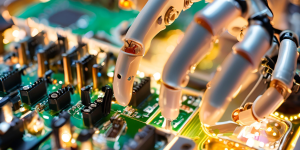Technology Spotlight: An Interview with BrainBox AI
By Tom Allport

 As part of Beaumont Bailey’s mission to connect founders, innovators, and key players that make up the fabric of our industry, our latest Technology Spotlight series highlights the success of our incredible members and wider network. In this instalment we speak with Andrew Fitzpatrick, UK & Europe Business Development Director at BrainBox AI.
As part of Beaumont Bailey’s mission to connect founders, innovators, and key players that make up the fabric of our industry, our latest Technology Spotlight series highlights the success of our incredible members and wider network. In this instalment we speak with Andrew Fitzpatrick, UK & Europe Business Development Director at BrainBox AI.
Andrew, could you share a bit about your career path and what led you to join BrainBox AI?
Absolutely. I’m an engineer at heart, I studied civil engineering at McGill University in Canada and spent the early part of my career working on large infrastructure projects. That period, around seven years in the field, really cemented my passion for the built environment.
After a while, I realised I needed to broaden my skillset, so I pursued an MBA at Bayes Business School in London. I explored different industries during that time but found myself constantly drawn back to buildings and the built environment.
My final MBA project was a business plan for BrainBox AI’s expansion into Europe. At the time, they hadn’t launched here yet, but they used that plan as a reference point. A year later, they got in touch and in 2021, I officially joined to lead our efforts across the UK and Europe. It was a full-circle moment and a great example of how academic work can lead to real-world opportunities.
For those unfamiliar, can you give us an overview of BrainBox AI and your role within the business?
At its core, BrainBox AI helps buildings operate in a smarter, greener and more efficient way using artificial intelligence. We’re headquartered in Montreal and have been operating for over eight years, with a particular focus on optimising HVAC systems, typically one of the biggest energy consumers in commercial buildings.
In January 2025, we were acquired by Trane Technologies, which will help us scale our impact globally. That said, our business will continue to go to market as BrainBox AI and use the existing brand for the foreseeable future.
I lead our business development across Europe. Being part of a lean team, I’m involved in a bit of everything, sales, account management, marketing, speaking at events and some project management too. It’s helped me develop a strong grasp of our product, from technical implementation to how we support client’s day to day.
What are the main challenges you’re solving for clients, and what are BrainBox AI’s core offerings?
We address two core challenges: reducing energy use in buildings and improving the efficiency of facilities management (FM) teams.
Commercial buildings account for roughly 30% of global greenhouse gas emissions, and HVAC systems are responsible for at least half of their energy usage. With increasingly unpredictable weather, these systems need to be much more dynamic and that’s where AI is really effective. Our solution can reduce HVAC energy consumption by up to 25%, which translates into both carbon and cost savings.
The second area is FM efficiency. There’s a serious shortage of FM professionals, 110,000 vacancies in the US alone and teams often spend most of their time reacting to issues rather than working proactively. Our tech helps by automating processes and supporting teams to manage buildings more efficiently.
Our three main solutions are:
- AI HVAC Optimisation – Our flagship solution connects to existing building systems, combining internal data with external sources like weather forecasts and occupancy. It creates predictive models and autonomously adjusts the system in real time.
- Cloud Building Management System (BMS) – A platform which allows owners to monitor and control multiple BMS systems remotely. It’s especially useful for large portfolios.
- ARIA – Our newest offering, developed with AWS. It’s a virtual building engineer, that helps FM teams optimise their operations through actionable insights diagnose and resolve issues quickly, using natural language interaction.
AI is in your company’s name, but how do you see its broader evolution in the built environment? How is BrainBox AI positioning itself within that transformation?
AI is quickly becoming integral to how buildings are designed, operated and managed. We’ve been building this capability from day one, it’s not something we’ve bolted on.
What’s encouraging is how many real estate companies now have dedicated AI strategies. They’re looking at how it can help across everything from asset acquisition and contract management to tenant engagement.
We focus on building operations because it’s one of the most data-rich and underutilised areas. Whether a company is just starting its decarbonisation journey or is already well down the path, our AI can deliver meaningful value along the way.
In terms of market focus, which sectors or asset classes are you most active in across Europe? And what are the key decarbonisation challenges you’re helping them tackle?
At present, we focus exclusively on commercial real estate. Residential buildings are challenging to modulate and optimise effectively based on daily household routines. Commercial assets, on the other hand, are more stable in terms of usage, which makes them ideal for automation.
In North America, we’ve seen strong results in multi-site retail, where consistency across buildings makes scaling much easier. Additionally in Europe, there’s more architectural variation and complexity in systems.
We work across retail, offices, shopping centres and airports. A key factor here is regulation. The EU’s Energy Performance of Buildings Directive and local frameworks like the UK’s MEES or France’s Tertiary Decree are pushing for major emissions reductions. In France, for instance, buildings are required to cut energy usage by 40% by 2030, with public accountability for those that don’t.
Compared to buildings on the other side of the pond European buildings are considered to be more efficient, which means there is sometimes less room for big optimisation gains. Plus, heat pumps are a lot more common here, but they can be tricky to fine-tune compared to traditional HVAC systems. With our projects here, we’ve adapted our technology to handle these challenges, so even in high-performing buildings, we can still help drive meaningful energy savings. And because our platform is so scalable, it works just as well across all sorts of building types and systems, making it a solid fit for Europe’s unique market. That’s challenged us to keep improving our technology to meet local needs.
One area that could be improved is how energy performance is measured. In the UK, EPC ratings are based on how buildings are designed, not how they’re used. It’s like buying an energy-efficient fridge and then leaving the door open, it doesn’t matter how good the design is if usage isn’t managed properly.
What opportunities do you see for BrainBox AI in Europe going forward, and how do they differ from North America?
Europe is incredibly diverse, both in terms of building stock and regulatory frameworks. That creates complexity, but also great opportunity.
Our initial deployments taught us a lot, about compatibility, about building operations, about how different clients work. Some of those first projects took longer than we expected, but we’ve since refined our approach and developed a more scalable model.
The big opportunity now is to expand across client portfolios. Once the solution is proven in one site, it can be replicated across dozens or even hundreds of locations. That’s where the biggest impact lies.
Looking ahead, what does the next 12 months look like for you and your team across Europe?
Growth is the focus. We’re coming to the end of several pilot projects and already discussing expansion with existing clients. Portfolio-wide rollouts are where we’ll have the biggest impact.
We’re also building out our partner network. Europe isn’t one market, it’s 20-plus, each with its own language, regulations and building practices. Strong local partners help us navigate those differences and deliver faster.
Aria is another major priority. We’ll be rolling it out with key clients this year and gathering feedback. It’s a significant shift in how FM teams interact with their buildings.
We also plan to expand our team, particularly in client-facing roles, sales, technical engineering and project delivery.
What skills or advice would you offer to someone looking to build a career in cleantech and AI-driven business development?
Firstly, get comfortable with AI tools. Just like Excel became a baseline skill, AI tools like ChatGPT or Copilot will become standard within the next few years. Learning to use them effectively now will give you an edge.
Secondly, immerse yourself in the sector. Go to events, read widely, listen to podcasts, just follow your interests. Cleantech and AI are vast fields and it helps to find your niche and focus on it.
And finally, relationships are key. Business development is about trust, clarity and adding value. Be consultative, not transactional. Get to know your clients, understand their pain points, and know your product well enough to help solve their challenges.
That means being close to the delivery too. Don’t just sell, get involved in the deployments. Ask questions. Understand how the solution works in practice. It’ll make you a better partner and build your credibility in the long term.
What challenges are you facing in attracting or retaining top talent in this space right now?
We see 3 main challenges today in this space: Skills Shortage, Rising Competition, and Rapid change in technology.
- Skill Shortage: There is a limited pool of professionals who possess both HVAC expertise and advanced AI skills. This makes it difficult to find candidates who meet the specific technical requirements.
- High Competition: The demand for AI talent is high across various industries, not just HVAC. Companies in tech, finance, healthcare, and other sectors are also competing for the same talent, often offering more attractive compensation packages and career opportunities.
- Rapid Technological Advancements: The field of AI is constantly evolving, requiring continuous learning and adaptation. Keeping up with the latest advancements can be challenging for both employers and employees.
The AI talent market is competitive, and people have options. Our focus has been on preserving our unique culture, emphasising our continued mission-driven work, and showing how the acquisition actually amplifies our impact rather than diluting it.
 If you would like to discuss any of the topics raised in this piece or if you need support with your leadership resourcing strategy, please get in touch with Tom Allport on: tom.allport@beaumontbailey.com.
If you would like to discuss any of the topics raised in this piece or if you need support with your leadership resourcing strategy, please get in touch with Tom Allport on: tom.allport@beaumontbailey.com.




